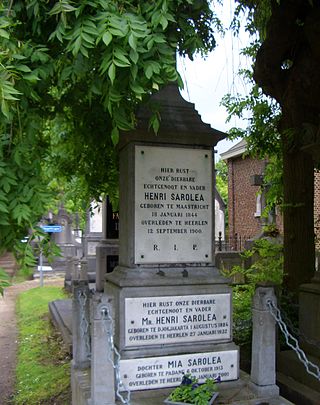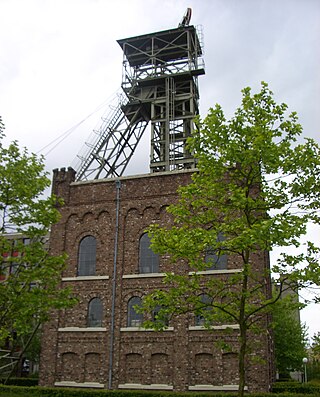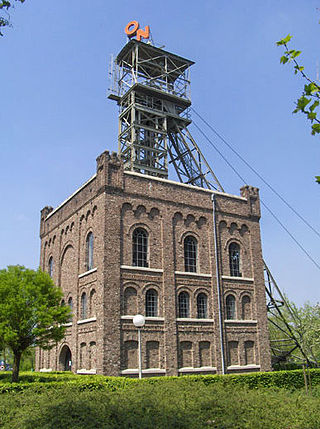
Mining is the extraction of valuable geological materials and minerals from the surface of the Earth. Mining is required to obtain most materials that cannot be grown through agricultural processes, or feasibly created artificially in a laboratory or factory. Ores recovered by mining include metals, coal, oil shale, gemstones, limestone, chalk, dimension stone, rock salt, potash, gravel, and clay. The ore must be a rock or mineral that contains valuable constituent, can be extracted or mined and sold for profit. Mining in a wider sense includes extraction of any non-renewable resource such as petroleum, natural gas, or even water.

Heerlen is a city and a municipality in the southeast of the Netherlands. It is the third largest settlement proper in the province of Limburg. Measured as municipality, it is the fourth municipality in the province of Limburg.

Anthracite, also known as hard coal and black coal, is a hard, compact variety of coal that has a submetallic lustre. It has the highest carbon content, the fewest impurities, and the highest energy density of all types of coal and is the highest ranking of coals.

Coal mining is the process of extracting coal from the ground or from a mine. Coal is valued for its energy content and since the 1880s has been widely used to generate electricity. Steel and cement industries use coal as a fuel for extraction of iron from iron ore and for cement production. In the United Kingdom and South Africa, a coal mine and its structures are a colliery, a coal mine is called a "pit", and above-ground mining structures are referred to as a "pit head". In Australia, "colliery" generally refers to an underground coal mine.

Prince of Orange is a title associated with the sovereign Principality of Orange, in what is now southern France and subsequently held by the stadtholders of, and then the heirs apparent of, the Netherlands.

Hoensbroek is a Dutch town in the municipality of Heerlen. It is situated in the southeast of Limburg, a province in the southeast of the Netherlands. Until 1982, Hoensbroek was a separate municipality.
The history of coal mining goes back thousands of years, with early mines documented in ancient China, the Roman Empire and other early historical economies. It became important in the Industrial Revolution of the 19th and 20th centuries, when it was primarily used to power steam engines, heat buildings and generate electricity. Coal mining continues as an important economic activity today, but has begun to decline due to the strong contribution coal plays in global warming and environmental issues, which result in decreasing demand and in some geographies, peak coal.
Drift mining is either the mining of an ore deposit by underground methods, or the working of coal seams accessed by adits driven into the surface outcrop of the coal bed. A drift mine is an underground mine in which the entry or access is above water level and generally on the slope of a hill, driven horizontally into the ore seam.

The Dutch State Mine (DSM) Emma, in Dutch Staatsmijn Emma, was a coal mine located in Treebeek, Heerlen run by the Dutch state through its company DSM. The mine was in operation from 1911 until 1973. It was the second-largest mine in the Netherlands, but it had the highest production of all Dutch mines at 109 megatonnes. Its deepest shaft III was 980 metres (3,220 ft) deep. After the 1963 merger with the DSM Hendrik the deepest shaft was 1,058 metres (3,471 ft) deep.

Grasbroek is a neighbourhood and former mining colony in the municipality Heerlen, Netherlands. The neighbourhood was built to serve the mine Oranje-Nassau I.

Henri Sarolea, was a Dutch railway entrepreneur and contractor who settled in Heerlen after having worked on the railways in the Dutch East Indies.

The Oranje Nassau IV, the last and smallest mine exploited by the Oranje Nassau Mijnen, started its life as a ventilation shaft for Oranje Nassau III. In 1910 the construction of a mine shaft was started. However the construction was halted and only reassumed in 1919, the mine became operational in 1927.
The mineral industry of Mozambique plays a significant role in the world's production of aluminium, beryllium, and tantalum. In 2006, Mozambique's share of the world's tantalum mine output amounted to 6%; beryllium, 5%; and aluminium, 2%. Other domestically significant mineral processing operations included cement and natural gas.

The Buffalo and Susquehanna Railroad was a railroad company that formerly operated in western and north central Pennsylvania and western New York. It was created in 1893 by the merger and consolidation of several smaller logging railroads. It operated independently until 1929, when a majority of its capital stock was purchased by the Baltimore and Ohio Railroad. At the same time, the B&O also purchased control of the neighboring Buffalo, Rochester, and Pittsburgh Railway. The Baltimore and Ohio officially took over operations of both roads in 1932.

The Oranje Nassau III was a Dutch coal mine located in Heerlen. The mine was in operation from 1914 until 1973. It was the third of four mines collectively known as the Oranje Nassau Mijnen.

The Oranje Nassau I was a Dutch coal mine located in Heerlen. The mine was in operation from 1899 until 1974.
The Oranje Nassau II was a Dutch coal mine located in Schaesberg. The mine was in operation from 1904 until 1971. It was the second of four mines collectively known as the Oranje Nassau Mijnen.

Mining has been practiced in Taiwan for hundreds of years. Sulfur was an early important resource collected on the island. Coal mining expanded in the 19th century to keep up with demand from increased foreign trade. Heavy industry was further expanded under Japanese rule, but air raids towards the end of World War II decimated mining infrastructure, falling below 19th century production levels. Copper mining expanded in the mid-20th century, but ended in the 1980s following a global collapse in the price of copper.

The Compagnie des mines de Béthune, sometimes called the sometimes called the Compagnie de Grenay after the name of the concession, was a French coal mining company in the Pas-de-Calais that was established in 1851 and nationalized in 1946. The company had 11 mines, each with one or more shafts for extraction of coal or ventilation. It had a large facility for screening and washing raw coal, and for producing coke and other secondary products. During World War I (1914–1918) the front line crossed the mining concession, with the northern part occupied by the Germans, but despite constant shelling production of coal continued. Coke production peaked at 565,195 tons in 1928. The company had two thermal electricity plants, and operated 159 kilometres (99 mi) of railway tracks. At its peak the company was one of the largest coal mining operations in the region, with 12,640 employees in 1945.

The Rheinisches Braunkohlerevier, often called the Rhenish mining area, is a lignite mining area or district in the Cologne Bay, on the northwestern edge of the Rhenish Slate Mountains. The mining of lignite using the open pit method has had a significant impact on the landscape here and led to the formation of several important industrial sites. The area includes the Zülpicher and Jülicher Börde, the Erft lowlands and the Ville, making it the largest lignite mining area in Europe. To a lesser extent clay, silica sand and loess are mined here. The area is the only active lignite mining area in what was West Germany during German partition and contains the mines with the largest surface area, greatest depth, and biggest annual output of coal.
















